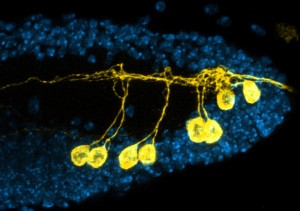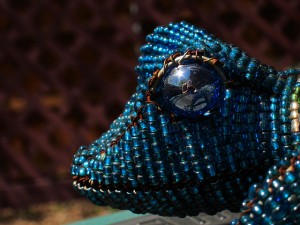Posted by Nicky Drayden on Oct 16, 2014 in
Reviews Lightspeed
http://www.lightspeedmagazine.com/fiction/the-hymn-of-ordeal-no-23/
Author Website: rhiannonrs.tumblr.com.
I’ll let the strength of this opening stand on it’s own:
Your brother’s bones, suspended in mineral fluids, turn as smoothly and shine as brightly as the oil-coated joints of the mechanism they guide. When you touch the heavy plastic that separates you from his body, it is cold. The iron plate that serves to cover what is left of his face turns towards the tapping, and nausea wells deep in your throat. You catch a glimpse of yellow fat, the hole of a socket, nerves that once bundled into the base of an eye now strung behind the iron half-mask.
Flesh did not make the transit to deep space whole, only guts packed in gel and nerves strung into wires, the delicate threads that extend to outer sensors, thrusters, and lenses. That is what they are now. Not people, not soldiers, but shrikes: the folded warbirds sent through void to cleanse it of the invaders, to impale them on their own stardust ruins, to leave broken chassis and frozen corpses scattered as warning to others who might threaten us. If the invaders left corpses—you have never seen them, only the scars of their passage left across the skin of Earth.
Interstellar war and deconstructed humans go together like peanut butter and jelly. Kind of a literal jelly, too, I guess, with lots of floating body bits. This story scores high on the ick factor, if you’re into that sort of thing. (**Raises hand**) But beyond that, this is a masterfully written piece of flash that grips you from beginning to end. There’s the lost sibling relationship that tugs at the heart strings. There’s the alien war and morality lines that get drawn in response. While the narrator never leaves Earth, the weight of space is constantly on her mind, across much of her lifetime. We all know that people come back from war changed, but what happens to the people like her brother who are changed so drastically before they even fight a single battle, reduced to strung nerves and gristle? So many deep questions are posed in this short piece and my only response to Rhiannon is: More, please!
Tags: Flash Fiction, Lightspeed Magazine, Nicky's Pick, Short Women in Space, Star Wars
Posted by Nicky Drayden on Oct 15, 2014 in
Reviews Crossed Genres
http://crossedgenres.com/magazine/013-the-gaps-in-translation/
Author Website: http://www.sharedepic.com/
In this story of a second contact, three humans visit a world inhabited by lizard-like people, some hundred years after the first contact. They are greeted by immediate differences based on what they’ve learned from the recordings of the first contact, specifically the flying “gliders” the lizzies now ride upon. Even the language has evolved, giving Miranda, the linguistics expert of the group, some trouble:
««Hello,»» Jago said, in the best lizzie that he had picked up from the old recordings. The lizzies hesitated and looked at him. Their faces were enough like humans that Miranda was almost fooled into thinking she could read the expression, but she caught herself. It looked like one of them smiled in amusement, but it could be a grimace, indicating offense.
««Hello,»» one of them replied. It looked at each of them in turn. ««You can come —- you will meet —– who —- you.»»
Miranda understood only pieces of what it said. Their chips were set to listen and recalibrate at first, making Miranda’s background studying theoretical neurolinguistics even more valuable for a few days. Though she was the expert on the lizzie language, she had trouble catching everything. The accent seemed to have changed and Miranda’s ear wasn’t ready for it.
««Repeat, please. Come where?»»
The lizzie clapped its hands, and curled its tail. Pleased. That was an action she’d seen in the recordings. It’d been a hundred years since the first brief visit. Enough time to record and observe, enough data to study that Miranda could learn to speak well enough.
I’m a sucker for linguistics stories, and love how language unfolds and mutates, so this was right up my alley. The lizard aliens were great, and I particularly enjoyed the terse and coy comments by Co, the elder lizard who was alive for the first contact. I really got a good feeling for the lizard culture and it seemed both alien and familiar at the same time. I was curious to learn more about their gender roles, though the story left that open. My one big hangup with this is that I never really bought into the human characters. Their actions seemed a little arbitrary to me and their decisions unfocused and unclear, especially towards the end of the story. While they were believable, even enjoyable as characters, I just didn’t believe that someone, somewhere would have decided they were the best fit for a mission as important as a second contact. That aside, this was a fun read, and it explores some interesting themes on the influences cultures can have upon one another.
Tags: Aliens, Crossed Genres, Language, Short Story, Short Women in Space
Posted by Nicky Drayden on Oct 13, 2014 in
Reviews Daily Science Fiction
http://dailysciencefiction.com/science-fiction/space-travel/ruth-nestvold/thirteen-ways-of-looking-at-a-monkey
Author Website: http://www.ruthnestvold.com/
A monkey is dead on the surface of Caipora–a lush, Earth-like planet that was assumed to be habitable by humans. On the exploration ship above the atmosphere, the champagne has already been uncorked, though after the second rhesus monkey is sent down and suffers the same fate as the first, it seems the celebrations were a bit premature. Who would care about the lives of two monkeys lost on the cusp of such a great discovery? Apparently, Pam, the monkeys’ keeper does. She’s got four monkeys left under her care, and is determined to keep it that way.
Vladaya wants to send Multik now. I argued that we should send a robot first, try to recover Jane’s body; we could examine it in quarantine and determine the cause of death. But Ikuru said Jane could have eaten something, although she’s trained not to. Putting the blame on me and Jane. I said there’s no evidence, but Vladaya sided with Ikuru, saying we couldn’t know for sure. Before we try picking her up with a robot, it would be easier to send down another monkey.
Easier.
In this flash piece, we catch a glimpse of a woman who has become attached to what were intended to be tools. Though she takes her passions to an extreme, her decision to question the moral dilemma is a valid one. Why is one life worth more than another? It may be easier to raise and train these monkeys than it is to build and send down a robot, but that doesn’t make it the right decision. Or the wrong one, depending on your stance. It isn’t as if this is the first time animals have been used to further science. Should their sacrifices be held in the same regard as those as their human counterparts? It is a fine line to walk. This story is a simple one, but the questions it dredges up are quite complex. If space exploration were looked at as a cross-species endeavor, would it shift the view? One day, when the first dog on Mars is playing fetch with her person, maybe we’ll find the answer in the wag of her tail.
 In 1957, Laika became the first animal launched into orbit, paving the way for human spaceflight.
In 1957, Laika became the first animal launched into orbit, paving the way for human spaceflight.
Creative Commons
Tags: Daily Science Fiction, Flash Fiction, Monkeys, Short Women in Space, Space Exploration



